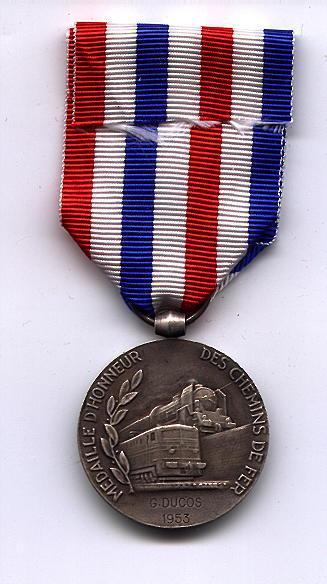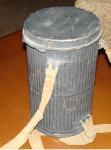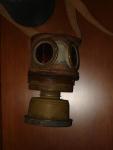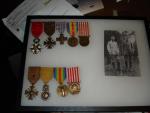-
Posts
1,784 -
Joined
-
Last visited
-
Days Won
3
Content Type
Profiles
Forums
Blogs
Gallery
Events
Store
Everything posted by Michael Johnson
-
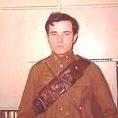
France French Médaille d'Honneur des Chemins de Fer
Michael Johnson replied to Michael Johnson's topic in France
To give an idea of what it was like to be a cheminot during the Occupation, several hundred were shot by the Germans, 1100 of 2480 deported died, and 2361 were killed in bombings, strafings, etc. A simple medal, but a lot behind it. -
[attachmentid=51670][attachmentid=51671] An interesting medal. There have been four issues of this medal. The medals illustrated are from the second (silver) and third (vermeil) issues. Many of the second issue were awarded during 1939-45 - definitely not a good time to be working on continental railways. The silver medal was awarded for 25 years' service, or for acts of courage or devotion to duty. It was also awarded to those forced to retire due to injuries.
-

Medals for service in Iraq
Michael Johnson replied to mariner's topic in Modern Campaigns and Conflicts
Flogging medals is the reason that so many groups are found with First War medals and renamed South Africas, IGSMs, etc. When they were recalled from the Reserve, or had listed their previous service, they risked a charge of being "improperly dressed" if they didn't have at least the ribbons up. My wife's grandfather had a name-erased trio up when he enlisted in the R.C.A.F. in the Second War. His step-mother had thrown his medals away! -

Medals for service in Iraq
Michael Johnson replied to mariner's topic in Modern Campaigns and Conflicts
Peter serves in the 1812 Royal Newfoundland Regiment out of Penetanguishene Ontario. What most people don't know is that he's been there since 1812. -

France The national defence medal (France)
Michael Johnson replied to Chris Boonzaier's topic in France
Here it is, Chris! http://cgi.ebay.ca/medaille-defense-nation...1QQcmdZViewItem -
The Canadian casualties were mostly in the course of operations, from land mines. The Indians, however, took several casualties during the Israeli attack, as I believe the Yugoslavians did as well.
-

Meritorious Service Medal
Michael Johnson replied to DavidM's topic in Great Britain: Orders, Gallantry, Campaign Medals
MiDs were used for good service, but the Military Medal (unlike the U.S. Bronze Star) was for gallantry in the field only. -

Meritorious Service Medal
Michael Johnson replied to DavidM's topic in Great Britain: Orders, Gallantry, Campaign Medals
Well, the number matches with the London Gazette entry. The card will list his campaign medal entitlement and might mention his M.S.M., but won't have any citation, probably just a reference to the London Gazette. -

Meritorious Service Medal
Michael Johnson replied to DavidM's topic in Great Britain: Orders, Gallantry, Campaign Medals
David, You might want to post at the Forum at www.theaerodrome.com (several GMIC members are also regulars there). There are more experts there, and I'm sure you'll be able to get more information on your grandfather. I'm wondering if this is your grandfather Medal Index Card. Your case is not unique. My wife's grandfather's medals were pitched by his stepmother, probably as he was on his way to Canada. -

Denmark Danish? Artillery field cap
Michael Johnson replied to Avitas's topic in Northern European & Baltic States
"Talla" is Spanish for size. -
About thirty years ago, amongst the Martini-Henry Mk. IVs that hit the market were a number of Mausers with Boer names carved on the butts, released from the Rawalpindi Arsenal, if memory serves. Their story was interesting. Apparently the British had two problems: a. What to do with arms captured in South Africa, and b. How to arm the Frontier Constabulary with modern arms, without giving them British service rifles. The solution to both was to send the Mausers to India. If the Mausers were stolen, the ammunition supply was limited, and couldn't be augmented by ammunition stolen from the British and Indian regiments.
-
The Irish Regiment of Canada was unusual in that it was originally a Toronto unit, but in 1965 it was reduced to nil strength, and an artillery unit in Sudbury was converted to the "2nd Battalion, The Irish Regiment of Canada". This title appears to be the modern version formerly worn on the former garrison jacket.
-

R/Q/M Havildar
Michael Johnson replied to Riley1965's topic in Great Britain: Research, Documentation & History
One faint hope would be if he was commissioned as a VCO. The Gazette would show "1346 RQMH Allah Ditta to be Jemadar" or similar wording. Unfortunately I would doubt that many Quartermaster-Havildars would have been commissioned, the openings would more likely go to Company Havildar-Majors. -
A search of B.C. death records gives: Name: RIDLEY DODDS Gender: Male Age: 63 Death Date: 5 May 1968 Place of Death: SALMON ARM Registration #: 1968-09-006643 A further check at www.ancestry.ca shows that he was born in 1904 in Newcastle-on-Tyne, Northumberland, England. So he would have been 35 when war was declared. By the time the N.R.M.A. was in force April 1941, he would have been almost 37. He may well have been conscripted and spent the war on coast defence duties. I can't see him waiting until late 1943 to volunteer, and miss his CVSM for insufficient time. By that point 37-year-olds weren't sent overseas, at least by the Army. You might try to locate an obituary in B.C.
-
Interesting. 1. The suspender is to hang the medal from. One to five place bars were sent out (if you had more than five you overlapped them to fit the five-place bar. The ribbons were made long enough to allow for a piece to be cut off for a ribbon bar. At this time these would be a piece of card, plastic, or buckram with the ribbon(s) sewn around it, then the whole was stitched to the uniform. 2. This also verifies that it was Dodd's only medal. 3. If this is his only medal, then he had a minimum of 28 days' service. 4. The lack of a Canadian Volunteer Service Medal might mean that he was an N.R.M.A. man (conscript) who did not go active, but since the CVSM required 18 months' service (6 months, if part was outside Canada), he could have been a late enlistment who served in Canada. If he was active service and invalided, he would have been granted the CVSM.
-
Le Gloan has the distinction of having shot down 5 biplanes in his total score - four Italian C.R. 42s and a British Gloster Gladiator. He was killed flying a P-39 with the Free French Air Force.
-

Roll of Honour Afganistan
Michael Johnson replied to bigjarofwasps's topic in Modern Campaigns and Conflicts
Canada has also paid a high price. CBC: Canada's Afghanistan casualties -
Beautifully. Marcel had the inner case cut out to accommodate the dent. The family history is that it was a shell fragment (obus) that did the damage. I know he was wounded, but am not sure whether it was this incident or not. Then there is his gas mask. Complete but very brittle, and one lense is cracked. His helmet is shown in the thread on Mdl 15 French helmets.
-
Here's a little frame I put together for Oncle Marcel (left in photo). The Légion d'honneur came from his estate. We have a photo of him with the Croix de Guerre avec ?toile. The Croix de Combatant is speculative as I have no way of knowing whether he applied for his card. Victory and Commemorative complete the group. He was also entitled to the Médaille des Blessés. The lower set represent the medals of his nephew, Adjt. Antonin Gautier (right in the photograph). He was killed in a collision with a squadron mate.



